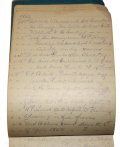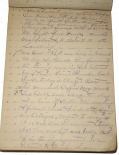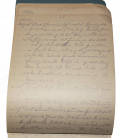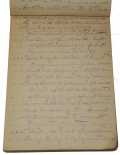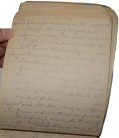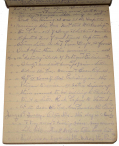site search
online catalog
JOURNALS OF ANDREW VAN EMAN WILSON, 77th OHIO

$750.00 SOLD
Quantity Available: None
Item Code: 1052-164
Wilson was born 3/26/1842 in Beaver County, Pa. At the beginning of the war, he was living in Washington County, Ohio, on a farm with his parents and five siblings. He joined the army in late August 1861, mustering into Co. C 77th Ohio as a private 10/5/61. Records sometimes list him as 18, a matter of book-keeping: at 17 he could sign up with permission of a parent or guardian and most mustering officers simply listed such recruits as 18, the minimum age required. He was promoted corporal 12/10/61 and by the time he mustered out 12/10/64 at Little Rock, AR, he had made sergeant, at least according to his tombstone in Grandview Cemetery in New Matamoras, Washington County, Ohio, where he died 3/28/1913, having returned to Washington County and farming after the war.
The 77th was an active regiment, losing 2 officers and 68 enlisted men killed or mortally wounded during its service serving in the District and Army of West Tennessee, the Department of Arkansas and the Army and Department of the Gulf. The Union Army lists its major battles as, Shiloh, Falling Timbers, Siege of Corinth, Little Rock, Okolona, Prairie d'Ane, Marks’ Mills, Jenkins' Ferry, and Spanish Fort: “So reduced was the regiment by the losses in its first engagement at Shiloh, and by sickness, details and straggling, that it numbered but a little over 200 men, with 13 officers, the loss in the battle and the subsequent affair at Falling Timber being 50 killed, 114 wounded and 56 missing - total, 220. Gen. Sherman commended the conduct of the regiment in its determined and protracted struggle for the position at Shiloh church and in baffling the enemy in all his attempts to capture Taylor's battery. The regiment took part in all the active operations of Sherman's division during the siege of Corinth, constructing fieldworks, roads and bridges, picketing, skirmishing and fighting, until the division rested beyond Corinth, returning from pursuit of the enemy. From Aug., 1862, until July, 1863, it was in charge of the military prisons at Alton, Ill. A portion of the regiment was captured at Marks’ Mills, and those not captured lost at Jenkins' ferry, in killed and wounded, more than half their number. Its strength at time of muster out was 365.”
Wilson was apparently a lifelong diarist and devoted time in later years to transcribing his earlier diaries and memoranda. This group consists of seven notebooks dating around 1900 to 1913 into which he transcribed earlier diaries. Given the numbers he assigned to some of these, he must have had a fairly large collection by the time of his death. Four of these are numbered and cover the dates as follows: #11 Aug 17 1874 to May 31, 1876 (about 200 pages;) #24 May 18 1888 to Sept 20, 1889 (about 150 pages;) #25 Sept 21 1889 to Nov 18 1890 (about 150 pages;) #24 “series No. 2” July 16, 1913 to Nov 21, 1913 (about 150 pages.) This last seems to be contemporary entries, ending just a week before his death on 11/28/1913. A fifth notebook is short, about 50 pages, covering April and May 1898. Daily entries in the above cover personal matters, farm business, weather, etc., and vary from 3 lines to half a page.
His Civil War entries are in two of the volumes. The main one contains 145 pages and has entries from his enlistment Aug. 29, 1862, to Dec. 29, 1863, which he seems to have transcribed in 1908. His entries vary from one line to five or six and have some good details about the regiment’s activities leading up to Shiloh and the aftermath. The organization becomes rather idiosyncratic after page 42. He reaches September 1862 and then goes back for couple of pages to fill in details of February and March. On page 45 he starts off with January 1, 1863, and for the rest of the volume seems to be transcribing entries by the day of the month, month by month: i.e., Jan. 7, Feb. 7, March 7, etc., and then moving on to Jan. 8, Feb. 8, March 8, etc., all going to the 16th day on the odd numbered pages, at which point he goes back to page 58 and begins with the 17th day of each month using the even numbered pages. We have no idea why he adopted this method, if it can be called that, other than that the winter nights must have been very long. Interspersed are lists of expenses from his memoranda at the time, a list of deaths in the regiment, etc. The order of the entries can be challenging, but the information is good, with lots of details about movements of the regiment, reception of news of the “great disaster” and the “army annihilated” at Chancellorsville, but also news of the fall of Vicksburg, etc.
A second notebook, lacking its cover, is equally long, but seems to contain only about 50 pages of wartime material dating 1862 and 1863, of which half seems to be taken up with a company roll and various expenses. A note indicates he was acting as the company orderly sergeant at the time and the commanding officer was sick. The other material dates from 1866 to 1874, consisting of some diary entries and many cash accounts, etc., with occasional notations indicating he is looking at them or transcribing them as late as 1908. The paper has yellowed and the ink in places is light, but the entries can be made out.
This would be an interesting source for someone interested in the regiment. In some cases, Wilson seems to be making extracts from his original entries, but there is still a lot of good detail for its day-to-day doings. [jet] [ph:L]
~~~~~~~~~~~~~~~~~~~~~~~~~~~~~~~~~~~
THIS ITEM, AS WITH ALL OTHER ITEMS AVAILABLE ON OUR WEB SITE,
MAY BE PURCHASED THROUGH OUR LAYAWAY PROGRAM.
CLICK HERE FOR OUR POLICIES AND TERMS.
THANK YOU!
Inquire About JOURNALS OF ANDREW VAN EMAN WILSON, 77th OHIO
For inquiries, please email us at [email protected]
Most Popular
Historical Firearms Stolen From The National Civil War Museum In Harrisburg, Pa »
Theft From Gravesite Of Gen. John Reynolds »
Selection Of Unframed Prints By Don Troiani »
Fine Condition Brass Infantry Bugle Insignia »
British Imported, Confederate Used Bayonet »
Scarce New Model 1865 Sharps Still In Percussion Near Factory New »
featured item
SCARCE 1859 DATED AMES LIGHT CAVALRY SABER, AKA MODEL 1860
Old habits die hard. Although we now know production of the new pattern cavalry saber intended to replace the heavy Model 1840 started in 1857, most still refer to them as the Model 1860. This is a scarce example of one produced by Ames in 1859 and… (2022-718). Learn More »
site search
Upcoming Events
May 16 - 18: N-SSA Spring Nationals, Fort Shenandoah, Winchester, VA Learn More »




